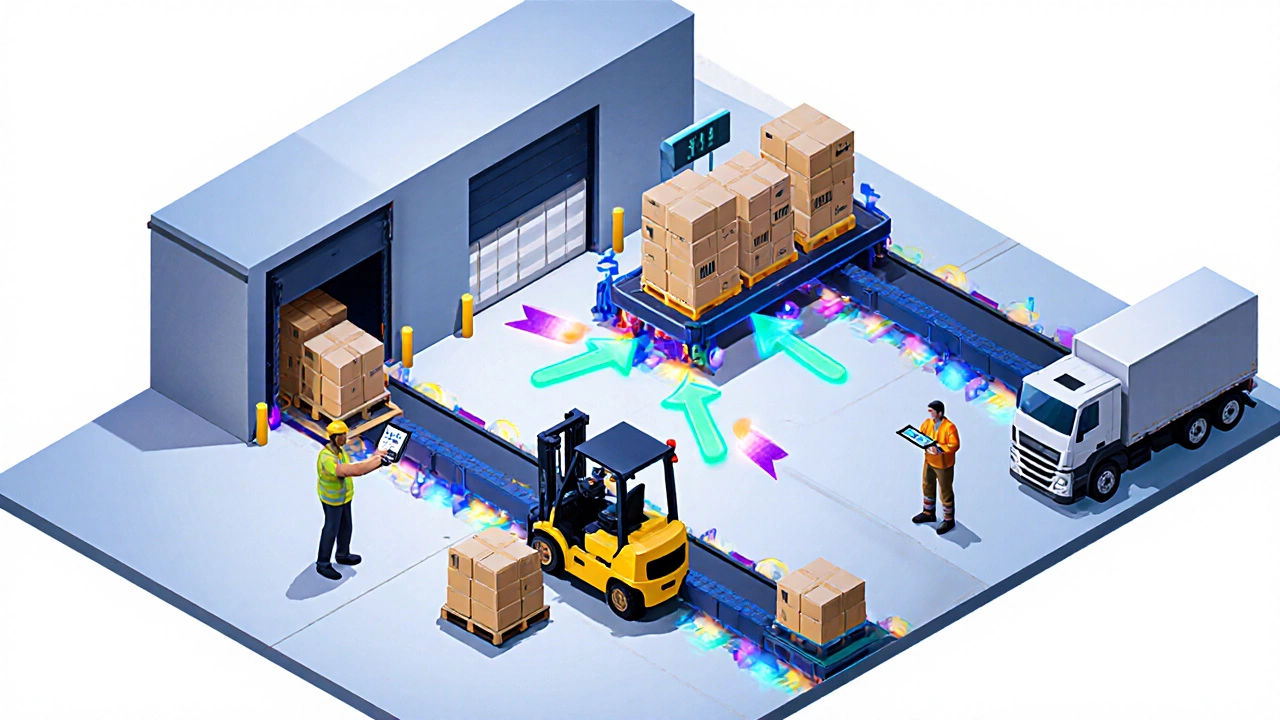Ever wondered what actually happens behind the scenes when a warehouse runs on SAP? In the next few minutes you’ll see how the system turns raw data into smooth inbound and outbound flows, why managers trust it for accuracy, and which steps matter most when you start a rollout.
SAP warehouse management is a suite of software tools that coordinate every movement of goods inside a storage facility. It plugs into the broader SAP ERP ecosystem and translates business orders into concrete tasks for forklifts, conveyors, and pickers. The result is a digital twin of your warehouse that knows what’s on every shelf, when it arrived, and where it needs to go next.
Understanding the core SAP modules for a warehouse
SAP offers three main ways to handle warehouse operations, each targeting a different scale and complexity.
- SAP WM (Warehouse Management) - the original module, built on classic SAP ECC. It’s solid for small‑to‑mid size sites that need basic receipt, putaway, and picking functions.
- SAP EWM (Extended Warehouse Management) - a modern, highly configurable engine that runs on SAP S/4HANA. It adds advanced features such as wave planning, labor management, and yard logistics.
- SAP S/4HANA - the next‑generation ERP platform where EWM lives as a native component. It enables real‑time analytics and a streamlined data model.
Choosing the right option depends on order volume, automation level, and future growth plans.
Step‑by‑step: How SAP drives everyday warehouse tasks
Below is the typical flow from when a pallet touches the dock to when a customer receives the box, all orchestrated by SAP.
- Goods receipt (GR): An inbound delivery is created in SAP ERP. The system assigns a delivery number, pulls purchase order data, and prints a barcode label.
- Dock appointment: Using SAP EWM, the dock door is scheduled, and the receiving team sees the expected quantity on a Fiori dashboard.
- Putaway planning: The system calculates the optimal storage location based on slotting rules, product dimensions, and current capacity.
- Physical move: Forklift operators scan the barcode (or RFID tag) at the source and destination. SAP validates the move in real time.
- Inventory update: Stock quantities, batch numbers, and serial numbers are posted automatically, keeping the inventory count accurate.
- Order fulfillment: When a sales order arrives, SAP creates a picking request, groups items into a wave, and sends the list to handheld pickers.
- Pick‑to‑light or voice picking: The chosen technology guides the worker to the correct bin, reducing travel time.
- Goods issue (GI): After packing, SAP registers the shipment, updates financials, and sends an ASN (Advanced Shipping Notice) to the customer.
- Returns processing: If a product is returned, SAP creates a reverse goods receipt, checks condition, and places the item back into inventory or a quarantine area.
Each step logs a timestamp, a user ID, and any exception codes, giving managers a full audit trail.
Key technologies that enhance SAP’s warehouse capabilities
Modern warehouses rarely rely on keyboards alone. SAP integrates with several hardware and software layers to boost speed and accuracy.
- RFID - tags broadcast item information, allowing scanners to read dozens of pallets in seconds.
- Barcode scanners - the workhorse for most pick‑to‑order processes.
- SAP Fiori - a web‑based UI that runs on tablets, giving floor staff a clear, touch‑friendly view of tasks.
- IoT sensors - monitor temperature, humidity, and motion, feeding data back into SAP for compliance checks.
- Robotic process automation (RPA) - handles repetitive data entry, such as creating inbound deliveries from EDI messages.
When these tools talk to SAP, the system can trigger automatic alerts-for example, a temperature breach that forces a product into quarantine.

Why businesses choose SAP for warehouse operations
Here are the most compelling reasons, backed by real‑world numbers.
- Real‑time inventory visibility reduces stock‑outs by up to 30% (studies from Gartner, 2024).
- Automated putaway and picking cuts labor hours per order by 15‑20% (case study: a European consumer‑goods firm).
- Integrated financial posting eliminates manual reconciliation, saving on average 8hours per week per warehouse.
- Scalable architecture lets you add new locations without re‑coding, which is essential for omnichannel expansion.
All of this stems from a single source of truth: SAP stores every transaction, from the moment a pallet is scanned to the moment an invoice is generated.
Common pitfalls and how to sidestep them
Even with a solid system, projects can stumble. Below are the frequent traps and practical fixes.
- Under‑estimating data cleansing. Legacy inventory records often contain duplicates or missing unit‑of‑measure data. Run a dedicated data‑quality sprint before go‑live.
- Skipping process redesign. Simply “lifting and shifting” old paper forms into SAP creates bottlenecks. Map the end‑to‑end flow and redesign for automation.
- Neglecting change management. Floor staff need hands‑on training with Fiori and mobile scanners. A “train‑the‑trainer” approach accelerates adoption.
- Over‑customizing early. Each custom field adds upgrade complexity. Start with standard functionality; add extensions only when a clear ROI appears.
- Ignoring integration testing. EWM must talk to ERP, transportation management, and finance modules. Use SAP’s Test Automation Framework to run end‑to‑end scenarios.
Addressing these issues early keeps the project on schedule and within budget.

Implementation checklist: From planning to production
Use this list as your roadmap. Tick each item before moving to the next phase.
- Define business objectives (e.g., reduce pick time by 10%).
- Inventory current hardware (RFID readers, scanners, mobile devices).
- Choose between SAP WM and SAP EWM based on volume and automation.
- Set up a sandbox environment on SAP S/4HANA.
- Run data migration scripts; validate stock balances.
- Configure inbound, putaway, picking, and outbound strategies.
- Integrate Fiori apps for warehouse operators.
- Conduct pilot runs in a single zone; collect KPIs.
- Train users, create SOPs, and establish a support desk.
- Go live with a cut‑over plan; monitor exceptions for 48hours.
- Review performance against objectives; fine‑tune parameters.
Following the steps reduces surprise downtime and helps you measure success right away.
SAP WM vs. SAP EWM: Quick comparison
| Aspect | SAP WM | SAP EWM |
|---|---|---|
| Platform | ECC / S/4HANA (as add‑on) | Native S/4HANA |
| Typical warehouse size | Up to 10,000 SKUs | Hundreds of thousands of SKUs |
| Advanced features | Basic putaway & picking | Wave planning, labor management, yard logistics, slotting optimizer |
| Integration depth | Standard ERP links | Tight real‑time integration with finance, transportation, and IoT |
| Implementation effort | 3‑6 months | 6‑12 months |
| License cost (indicative) | Lower | Higher, but includes more functionality |
Most midsize firms start with WM and upgrade to EWM when they need the extra automation layers.
Frequently Asked Questions
Can SAP WM run on the cloud?
Yes. SAP offers a cloud‑based instance of ECC and S/4HANA, allowing WM to be deployed without on‑premise hardware. The cloud version still requires the same configuration steps, but you gain automatic updates and scalability.
What’s the biggest advantage of EWM over WM?
EWM gives you granular control over labor, real‑time yard management, and sophisticated slotting algorithms. If your warehouse runs many thousands of orders daily, those capabilities translate into noticeable cost savings.
Do I need a separate team for SAP EWM?
Not necessarily. Many organizations let their existing ERP team handle the core configuration while a few power‑users manage day‑to‑day operational tweaks. However, a dedicated super‑user group speeds up issue resolution.
How does RFID improve accuracy?
RFID tags can be read without line‑of‑sight, letting you verify dozens of pallets at once. That cuts manual double‑checking and reduces mis‑picks by up to 25% in high‑throughput environments.
What’s the typical rollout timeline?
For a midsize site using SAP WM, expect 3‑6 months from kickoff to production. Switching to EWM pushes the timeline to 6‑12 months, mainly because of the deeper process redesign and integration steps.


